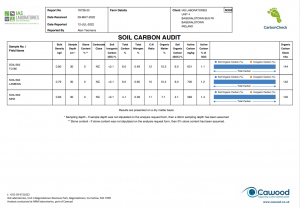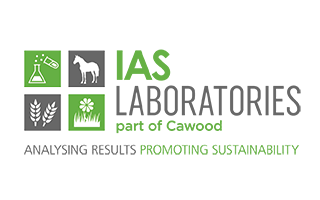CarbonCheck
CarbonCheck
CarbonCheck is a comprehensive soil carbon testing service developed by industry experts, customers and advisors to measure, monitor and benchmark carbon levels in your soil.

Our CarbonCheck service includes the following analyses, which combine to give a carbon stock measurement in tonnes per hectare.
CarbonCheck:
Includes assessment of carbon (organic, inorganic and total), nitrogen (C:N ratio), and density to calculate carbon stock and soil organic matter.
- Bulk density
- C:N ratio
- Total nitrogen
- Inorganic carbon
- Organic carbon
- Total carbon.
CarbonCheck Plus:
Includes assessment of carbon (organic, inorganic and total), nitrogen (C:N ratio), and density to calculate carbon stock and soil organic matter, plus active carbon to assess the portion of organic matter readily available to soil microbes.
- Bulk density – disturbed soil, scoop method. – reported as g/l
- Total carbon in soil – reported as %
- Total organic carbon in soil – reported as %
- Total inorganic carbon in soil – reported as %
- Total nitrogen in soil – reported as %
- Determination of permanganate oxidisable carbon (active carbon) in soil – reported as mg/kg
What is soil carbon?
Soil carbon is made up of organic and inorganic carbon stored in soils. Inorganic carbon is present in mineral form and levels depend on the soil type, whilst organic carbon is a component of organic matter and is vital to the soil ecosystem. The sequestration of carbon dioxide by soils is seen as a key opportunity to reverse atmospheric carbon dioxide pollution.
Regularly measuring carbon in soils is an effective way to benchmark soil health and plan how to improve it in the future.
There are many benefits of increasing soil carbon:
- Increased nutrient cycling
- Reduced nutrient inputs
- Increased biological activity of the soil
- Reduced atmospheric carbon
- Increased soil moisture retention
- Less drought prone in the Spring/Summer
- Slow water movement and reduce flood risk
- Soils warm more quickly in the Spring
- Sustainable crop production
The CarbonCheck report are presented in an easy to understand format and is straightforward to interpret.
Example:

Sampling Procedure for CarbonCheck
1. Plan where to take samples. Identify different areas or zones by considering the environmental landscape, soil type, land use and areas where different treatments have been applied. Once the areas have been divided into several relatively homogeneous units, called strata, apply random sampling within each stratum. Avoid patches with animal manure, animal pathways, field entrances, areas near water / feed troughs and other unusual features.
2. Sampling depth. The Food and Agriculture Organisation of the United Nations report on measuring carbon stock specifies a sampling depth of 30cm to account for the differences in the soil profile. On shallower soils, samples should be taken as deep as possible. The depth sampled should be provided on the request form accompanying the samples (otherwise assumed to be 30cm for carbon stock calculations).
3. How to sample. A minimum of 5 cores should be taken at random within each stratum to make a composite sample (a greater number of cores provide a more representative sample and the number taken should be appropriate to the size of the area covered). A clean auger should be used to take cores over the area in a W pattern.
4. Preparing the samples. Mix the soil cores for each composite sample in a clean container and remove all roots, plant material and accumulated surface organic matter. Select around 300g and put in a labelled grip seal bag.
To request your analysis, please download and print the IAS CarbonCheck Analysis Request form:
IAS Carbon Check Analysis Request
